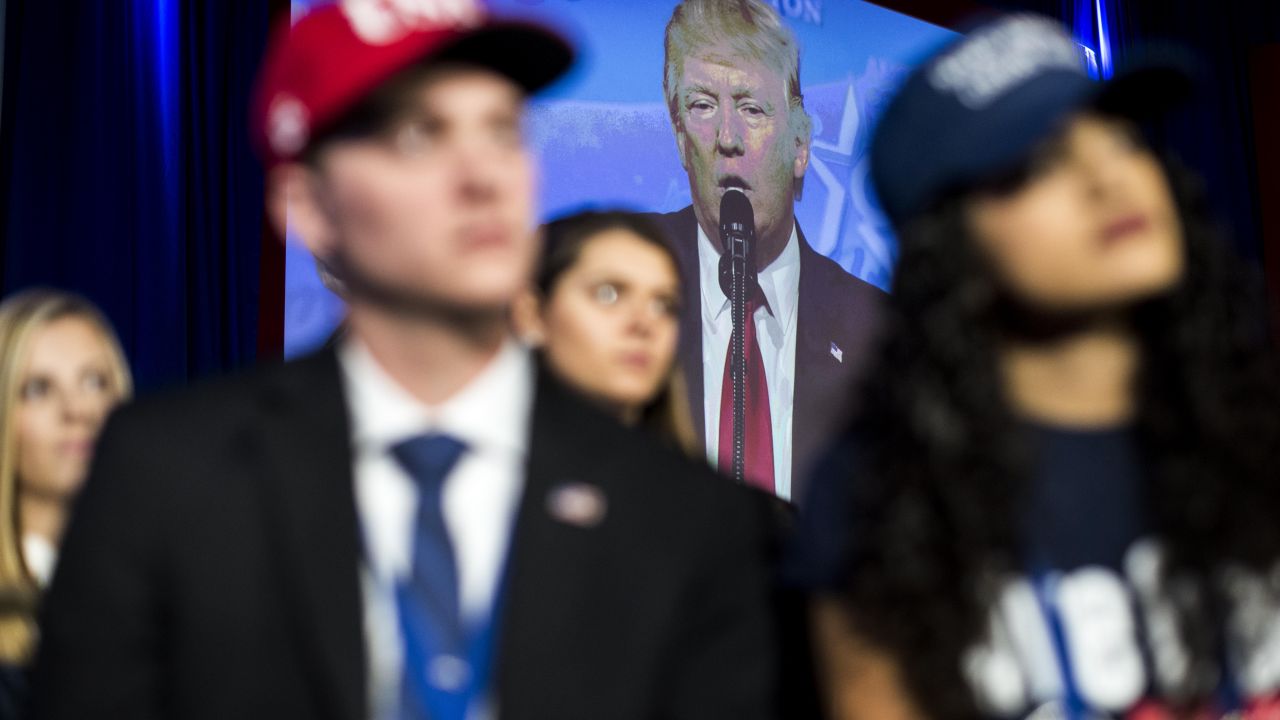
President Donald Trump speaks to a packed ballroom during the CPAC conference at the Gaylord Hotel and Convention Center in Oxon Hill, Maryland, Friday, February 24, 2017. (Photo by Melina Mara/The Washington Post via Getty Images)
WASHINGTON, DC — On Wednesday, Feb. 22, a young man boarded the complimentary shuttle at Washington, DC’s Union Station headed for the Conservative Political Action Conference (CPAC) taking place in suburban Maryland at the Gaylord National Resort & Convention Center. Talking excitedly to his friend, he said, “At first I couldn’t believe he was really going to come,” referring to President Donald J. Trump, who was added to the CPAC schedule at the last minute. “I heard it on CNN, and you know that’s fake news,” he explained.
Two days later, the president stood at the CPAC podium, deriding CNN as the “Clinton News Network,” and eliciting chants of “Lock her up!” from young CPAC-goers, who make up a good portion of the audience, thanks to discounted student tickets (all three conference days for $85).
The night before Trump’s CPAC address, CNN reported that White House Chief of Staff Reince Priebus had asked FBI officials to call major news outlets to pour water on stories published by CNN and The New York Times last week about communication between members of Trump’s inner circle and Russian intelligence agents during the presidential campaign.
Trump has been on a tear against CNN and the Times in recent weeks, alleging that they spread “fake news” and including them in a roster of mainstream media outlets he smeared in a Feb. 17 tweet as “the enemy of the American people.” (Also on the list are the news divisions of ABC, CBS and NBC.) From the CPAC podium on Friday, the president denied that he had claimed the news media writ large to be the people’s enemy; rather, it’s the “fake news” media who are.
The president never called CNN out by name in his speech; he left that to the audience. The game went like this: “Generally speaking, I can tell you the network,” Trump said, complaining of bad polls from a particular TV news operation. “Somebody said a poll came out,” he continued. “I say, ‘What network is it?’ And they’ll say, ‘A certain — let’s not mention names, right? Shall we?’”
Cue the audience. Loud, random shouts from the voices of young people roared through the room. “CNN!” they shouted. The president smirked and paced the stage.
Back at the White House, his press secretary prepared to deliver a briefing to reporters at a press conference that would specifically exclude CNN, The New York Times and other mainstream news outlets.
Trump implied in his speech to the CPAC audience that The New York Times made up the story of contacts between his campaign staff and Russian intelligence last summer. “I’m against the people that make up stories and make up sources,” he said. Of course, he never mentioned what the story was — never uttered the word “Russia” — but attacked its veracity based on the process by which it was obtained: anonymous sources. He suggested that news outlets not be allowed to publish stories based on anonymous sourcing.
“They get upset when we expose their false stories,” Trump said. “They say that we can’t criticize their dishonest coverage because of the First Amendment — you know, they bring up the First Amendment. And I love the First Amendment; nobody loves it better than me. Nobody.”
Just mere months ago, the term “fake news” meant something entirely different: it referred to false conspiracy stories about Hillary Clinton in the lead-up to the election. The stories were spread through social media, and sometimes emanated from fictitious news outlets. The phenomenon climaxed with shots fired into a Washington, DC, pizza parlor favored by high-profile Democrats by a North Carolina man who thought he was about to rescue children from a nonexistent sex ring a fake news source reported was run by Clinton.
The appropriation of the term by Trump and his supporters to discredit mainstream media is one of the great rhetorical heists of all time, and it was everywhere at CPAC. Numerous speakers used the term throughout the conference; the conference agenda offered these breakout sessions: “Fake Climate News Camouflaging an Anti-Capitalist Agenda — and What President Trump Plans to Do About It,” and one simply called “Fake News.”
By the end of the day, the Washington Post had broken the story of the administration’s engagement of high-level intelligence officials and members of Congress — including the chairmen of the intelligence committees in the House and the Senate — to call news outlets to dispute the details of the story about alleged contacts between Trump associates and Russian intelligence figures. That news, however, has to compete for attention with the spectacle of the president’s extraordinary attack on the free press. They are stories of equal importance, though completely different in nature. The former is a story its subjects never expected to see the light of day; the latter is one carefully constructed by the very same people who are vulnerable to the revelations of that spy story.
Reporters from competing mainstream news outlets showed signs of coming together to resist White House press secretary Sean Spicer’s punishment of excluding journalists from at least eight news organizations in his Friday briefing. Reporters from the AP and TIME boycotted the session in solidarity with reporters from the excluded outlets, a list that included The New York Times, CNN, Politico, BuzzFeed, the BBC, The Hill, the New York Daily News and the Los Angeles Times. Several right-wing news organizations that are not part of the White House pool were added to Spicer’s briefing list, including The Washington Times, One America News Network and Breitbart, the entity remodeled by Stephen K. Bannon, who is now the president’s chief strategist, as “the platform for the alt-right.”
Calls for a select committee in Congress to investigate the Trump administration’s links to Russian intelligence continue to go unheeded.




